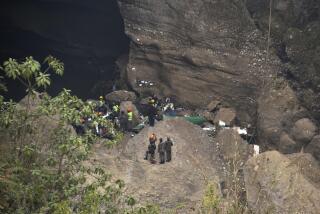‘Black box’ data show ‘clear similarities’ between Boeing jet crashes, official says

Reporting from Addis Ababa, Ethiopia — Ethiopia’s transportation minister said Sunday that information from the flight data recorder on the Ethiopian Airlines jet that crashed last week shows “clear similarities” with the crash of the same type of plane in Indonesia in October.
Dagmawit Moges told journalists that the condition of the “black boxes” — the data and voice recorders — was good and that enough data had been recovered that her ministry’s Accident Investigation Bureau would release a preliminary report in 30 days about what happened to Flight 302.
“During the investigation of the FDR [flight data recorder], clear similarities were noted between Ethiopian Airlines Flight 302 and Indonesian Lion Air Flight 610,” which will be the subject of further investigation, Dagmawit said.
READ MORE: How a 50-year-old design came back to haunt Boeing with its troubled 737 Max jet »
Initial data from the doomed Ethiopian Airlines flight as well as subsequent satellite information recovered showed an erratic flight path during the six minutes that the plane was in the air before it crashed into a field outside the capital, Addis Ababa, on March 10, killing all 157 aboard.

The plane ascended and descended and then ascended again, all the while flying at speeds well in excess of normal takeoff procedure. The pilot, Yared Getachew, was considered very experienced, with more than 8,000 hours of flying time.
Authorities around the world had agreed to ground the plane after the apparent similarities to the crash of the Lion Air jet in Indonesia in October, which also involved a Boeing 737 Max 8.
Ethiopian investigators on Thursday traveled with the voice and data recorders to France, where they are being analyzed by the Bureau of Inquiry and Analysis for Civil Aviation Safety.
Dagmawit said the U.S. National Transportation Safety Board also was involved in the analysis.
A preliminary report about the causes of the Lion Air crash pointed to erroneous data from a sensor causing the aircraft’s new automated stabilizer system to push the jet’s nose down. The pilots then struggled to pull the plane up, and it finally crashed into the Java Sea.
The minister’s comments Sunday suggested a similar series of events might have caused the Ethiopian Airlines crash.
In November, Boeing issued a bulletin for how to reset the stabilizer if it started to push the plane’s nose down.
Over the weekend, grieving family members were being given sacks of earth to bury in place of the remains of their loved ones.
Officials began delivering the bags instead of the remains because the identification process is going to take such a long time.
Families were each being given a 2.2-pound sack of scorched earth taken from the crash site, members of two different families told the Associated Press. They spoke on condition of anonymity to avoid any possible government reprisal. An Ethiopian government official who spoke on condition of anonymity because the official was not authorized to speak to reporters also confirmed the deliveries of soil.
“The soil came as it became impossible to identify bodies and hand over remains to family members,” one family member said. “We will not rest until we are given the real body or body parts of our loved ones.”
Forensic DNA work has begun on identifying the remains but it may take six months because the body parts are in small pieces. However, authorities say they will issue death certificates within two weeks. The victims of the crash came from 35 countries.
A mass memorial service was held in Addis Ababa on Sunday, one week after the crash. Muslim families have already held prayers for the dead and were anxious to have remains to bury as soon as possible.
Paul Schemm reports for the Washington Post. The Associated Press was used in compiling this report.
More to Read
Sign up for Essential California
The most important California stories and recommendations in your inbox every morning.
You may occasionally receive promotional content from the Los Angeles Times.










